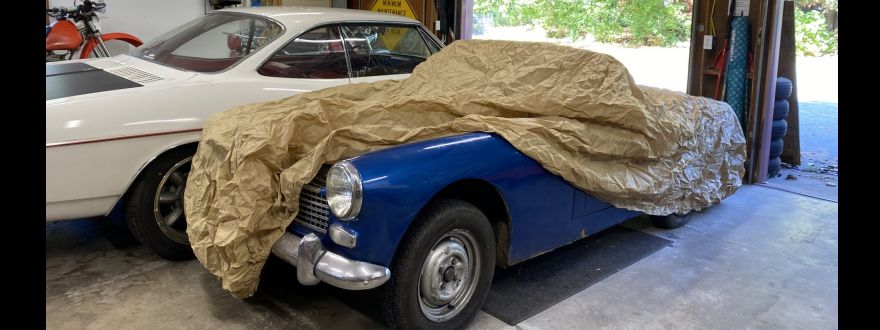
4 tips for protecting your car from day-to-day hazards
By Kyle Smith 10/06/20
We have money, time, and emotions tied up in our beloved vintage rides. To suffer damage to your machine—or worse, to have it stolen—is crushing for even most hardened gearhead. Still, we inevitably assume some risk in every situation of car ownership. Even leaving a car in a climate-controlled garage doesn’t eliminate every possible hazard. We’ve covered the step-by-step process of putting your car away for seasonal storage before, but today we’ve collected a few tips for short-term storage between drives.
Take care of your tires
I happened to have this rigid foam left over from some home projects, but even buying it new is very affordable—especially when compared to tires.
A co-worker of mine spent years in the tire industry, and I thoroughly enjoy picking his brain about rubber maintenance dos and don’ts. His favorite thing to do is give me a hard time about how I store the winter set of wheels and tires for my favorite passenger’s daily driver. I roll them under a workbench I have in a carport and forget about them until the seasons change. This is a bad idea, it turns out, and will limit the life of these tires—just like parking your vintage car on a concrete floor without protecting the tires.
Let’s get this out of the way first—this is not about flat spots. Flat spots formed during seasonal storage will likely disappear with a couple heat cycles from short drives. I’m talking about protecting your tires from concrete’s ability to pull moisture and oils from rubber. One tried-and-true method to prevent garage-stored tires from drying out is parking on some carpet squares. (You can typically ask the local carpet shop for some cast-offs or leftover samples.) This winter I plan to try out some 2-inch rigid insulation foam which might also help cradle the tire a bit to minimize flat spots.
Disconnect your battery
These disconnects take minutes to install and save me hours of worrying. Kyle Smith
I can still keep my battery tender hardwired while isolating the batteries voltage from the cars wiring harness.
There are a lot of things we love about our vintage rides, but the key concern, most of the time, is the fact they are vintage. Old cars mean old components; often times our cars are filled with parts operating well beyond the life expectancy any engineer would have imagined when building them. Electrical components are particularly worth addressing. No one wants to have their car self-immolate from a simple electrical short.
The solution here is a simple battery disconnect switch. I install these on all my cars just to help me sleep at night. These $10 or so screw-type versions are great, and I can even keep my hard-wired battery tender connected and charge the battery while it is isolated from the rest of the electrical system. In a perfect world, no vermin would chomp on our wires and cause problems, but we don’t live in such a place. It’s always better to discover a potential short while you’re nearby than to receive a call from your local fire department.
Put on a cover
Even a thin and affordable cover like this one can keep the paint from getting nicks and scratches while in the garage, and it only takes a few moments to throw on and off.
I have a confession to make, and I would bet most of you are guilty of this, too: I stack things on my cars from time to time. Folded-up cardboard boxes before they make it to the recycling, my motorcycle helmets, the occasional box of lightweight parts that I need off of my workbench for the afternoon. All this damages the paint of my beloved cars.
Luckily, none of my cars are that nice, but using them as storage shelves is still a bad habit. If I am going to continue doing this (and, without a serious intervention, I probably will), I need to purchase covers for my cars. Just a single layer of protection goes a long way to keeping paint in good shape and can even prevent some small dents and dings.
No leaning
This is an accident waiting to happen. I should move this to a spot where I can secure it to the wall so it doesn’t fall and damage itself.
Those car covers can stop a multitude of little hits, but a hood or motorcycle tipping off the wall won’t be saved by a layer of soft fabric. In my seemingly packed-to-the-ceiling garage, I have to actively remind myself not to lean things against others, however convenient. Whether it’s a broom or the hood to my Austin Healey Sprite, by leaving them unsecured and simply tipped against something I’m asking them to fall over and damage something.
Just walking through my garage with a box of new parts the other day, my shirt caught the handlebars of my Kawasaki KE175 motorcycle. Luckily, it was on a rubber-topped center stand and thus nearly tore my shirt without so much as shifting two inches. If it had been on the kickstand, the handlebars would have toppled into the front fender of the Corvair. A scary thought.
These are pretty simple tips, and I am sure there are a few I am missing. Leave a comment below in the Hagerty Community and share how you keep your beloved car safe from day-to-day hazards.
